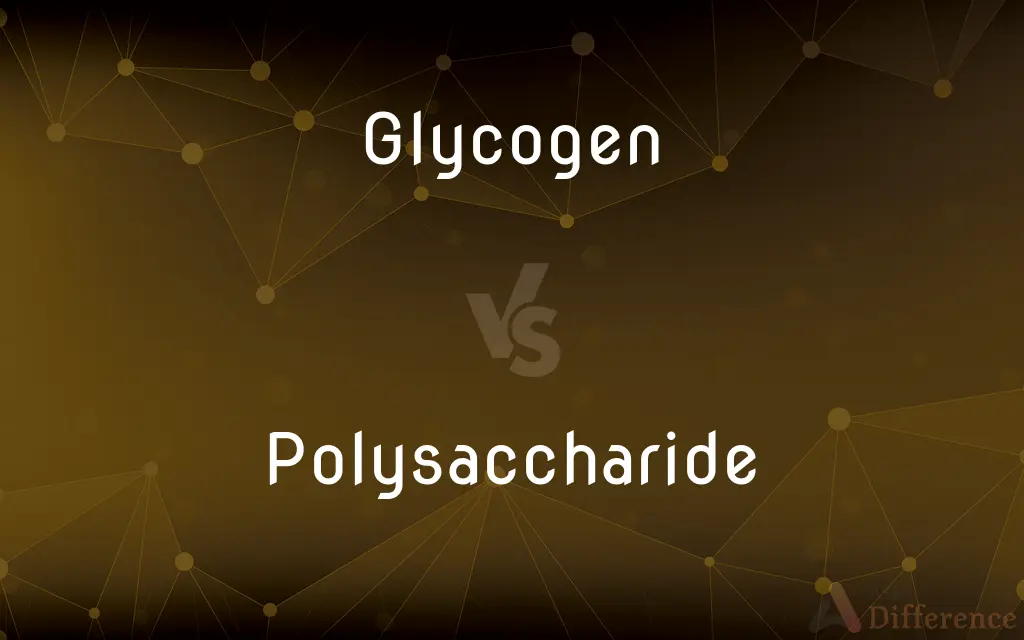Glycogen vs. Polysaccharide — What's the Difference?
By Fiza Rafique & Maham Liaqat — Updated on April 18, 2024
Glycogen is a complex, branched polysaccharide stored primarily in liver and muscle cells, while polysaccharides encompass a broad group of carbohydrate polymers like starch and cellulose.

Difference Between Glycogen and Polysaccharide
Table of Contents
ADVERTISEMENT
Key Differences
Glycogen serves as a primary storage form of glucose in animals, particularly concentrated in the liver and muscle tissues. Whereas polysaccharides represent a larger category of carbohydrates that includes various types like starch, cellulose, and glycogen itself, found both in animals and plants.
Glycogen's structure is highly branched, allowing for rapid glucose release when energy is needed. On the other hand, other polysaccharides such as cellulose have a more linear structure, contributing to plant rigidity and high dietary fiber.
Glycogen synthesis and degradation are tightly regulated by hormonal signals, reflecting its role in energy metabolism. Polysaccharides, in contrast, may serve diverse functions not just in energy storage but also in structural support and immune defense across different organisms.
While glycogen is quickly mobilized to maintain sugar levels, other polysaccharides like starch are digested more slowly, impacting their role in nutrition and energy management.
The synthesis of glycogen involves enzymes like glycogen synthase, emphasizing its specialized role in animal metabolism, whereas polysaccharide synthesis varies widely among different types, involving a variety of enzymes tailored to specific biological functions.
ADVERTISEMENT
Comparison Chart
Definition
A storage carbohydrate in animals.
A class of carbohydrates forming multiple sugar units.
Location
Primarily in liver and muscle cells.
Found in various biological sources, including plants and animals.
Structure
Highly branched molecule.
Structure varies: can be branched or linear.
Function
Quickly mobilizes glucose for energy.
Varies from energy storage to structural support.
Enzymes Involved
Glycogen synthase, glycogen phosphorylase.
Varies: includes starch synthase, cellulase, etc.
Compare with Definitions
Glycogen
Glycogen is the main storage form of glucose in animals.
Humans store glycogen in the liver and muscles for energy.
Polysaccharide
Polysaccharides are carbohydrates composed of long chains of monosaccharide units.
Cellulose in plant cell walls provides structural support.
Glycogen
It is a highly branched molecule, enhancing rapid glucose release.
During exercise, muscle glycogen is broken down to fuel muscle contractions.
Polysaccharide
They can be either structural, like cellulose, or storage, like starch.
Starch in potatoes serves as an energy reserve.
Glycogen
Glycogen levels are influenced by diet, particularly carbohydrate intake.
Post-meal, glycogen stores increase as glucose is converted into glycogen.
Polysaccharide
Polysaccharides vary in structure from linear to highly branched.
Chitin provides rigidity to the exoskeletons of insects.
Glycogen
Glycogen storage diseases affect how the body processes sugar.
People with glycogen storage diseases may experience muscle pain or weakness.
Polysaccharide
Polysaccharides are essential for various biological functions.
Bacterial polysaccharides can help evade immune detection.
Glycogen
It plays a critical role in maintaining glucose levels.
During fasting, liver glycogen is converted back to glucose.
Polysaccharide
Digestion of polysaccharides depends on their structure.
Humans cannot digest cellulose because they lack the enzyme cellulase.
Glycogen
Glycogen is a multibranched polysaccharide of glucose that serves as a form of energy storage in animals, fungi, and bacteria. The polysaccharide structure represents the main storage form of glucose in the body.
Polysaccharide
Polysaccharides (), or polycarbohydrates, are the most abundant carbohydrate found in food. They are long chain polymeric carbohydrates composed of monosaccharide units bound together by glycosidic linkages.
Glycogen
A polysaccharide, (C6H10O5)n, that is the main form of carbohydrate storage in animals and is found primarily in the liver and muscle tissue. It is readily converted to glucose as needed by the body to satisfy its energy needs. Also called animal starch.
Polysaccharide
A carbohydrate (e.g. starch, cellulose, or glycogen) whose molecules consist of a number of sugar molecules bonded together.
Glycogen
(carbohydrate) A polysaccharide that is the main form of carbohydrate storage in animals; converted to glucose as needed.
Polysaccharide
Any of a class of carbohydrates, such as starch and cellulose, consisting of a number of monosaccharides joined by glycosidic bonds.
Glycogen
A white, amorphous, tasteless substance resembling starch, soluble in water to an opalescent fluid. It is found abundantly in the liver of most animals, and in small quantity in other organs and tissues, particularly in the embryo. It is quickly changed into sugar when boiled with dilute sulphuric or hydrochloric acid, and also by the action of amylolytic ferments.
Polysaccharide
(carbohydrate) A polymer made of many saccharide units linked by glycosidic bonds.
Cellulose, starches, and complex carbohydrates, such as glycogen, are common polysaccharides in biology.
Glycogen
One form in which body fuel is stored; stored primarily in the liver and broken down into glucose when needed by the body
Polysaccharide
Any of a class of carbohydrates whose molecules contain chains of monosaccharide molecules
Common Curiosities
What is glycogen?
Glycogen is a complex branched polysaccharide that stores glucose in animal tissues, especially in liver and muscles.
How is glycogen utilized in the human body?
In humans, glycogen is broken down into glucose as needed to maintain adequate blood sugar levels, especially during fasting or physical activity.
How does glycogen differ from other polysaccharides?
Glycogen is specifically tailored for quick glucose release in animals, whereas other polysaccharides may serve structural or slower energy release roles in various organisms.
How do glycogen and starch differ in their roles?
While both serve as energy storage, glycogen is for rapid energy release in animals, and starch serves as a more gradual energy source in plants.
What are common sources of polysaccharides?
Polysaccharides are found in a wide range of sources, including plant-based foods like fruits and vegetables, and as structural components in plants and animals.
What role do polysaccharides play in nutrition?
Polysaccharides, such as starch and cellulose, are important dietary fibers that aid in digestive health and sustained energy release.
Can humans digest all types of polysaccharides?
Humans can digest polysaccharides like starch but not cellulose, as they lack the necessary enzyme to break down its beta bonds.
What enzymes are involved in glycogen metabolism?
Enzymes like glycogen synthase and glycogen phosphorylase play key roles in glycogen synthesis and degradation, respectively.
What is the significance of glycogen in diabetes management?
For diabetics, managing glycogen breakdown and synthesis is crucial for controlling blood sugar levels and preventing spikes or drops.
How does the structure of glycogen contribute to its function?
The branching structure of glycogen allows enzymes quick access to glucose chains, facilitating rapid release of glucose when needed.
Why can't humans digest cellulose despite it being a polysaccharide?
Humans lack the enzyme cellulase, necessary for breaking down the beta-glycosidic bonds in cellulose, which is abundant in plant cell walls.
How are polysaccharides important to plant structure?
Structural polysaccharides like cellulose are critical for plant rigidity and growth, forming the main component of cell walls.
What dietary advice is given regarding polysaccharides?
Dietary guidelines typically recommend a high intake of polysaccharides, especially fibrous ones like those in vegetables and whole grains, for health benefits.
What happens to glycogen during exercise?
During physical activity, glycogen stored in muscles is broken down to glucose, which is used to fuel muscle activity.
Are there medical conditions associated with glycogen?
Yes, various glycogen storage diseases affect how glycogen is synthesized or broken down, leading to symptoms like muscle weakness or hypoglycemia.
Share Your Discovery

Previous Comparison
Long vs. Prolonged
Next Comparison
Swath vs. TrimaranAuthor Spotlight
Written by
Fiza RafiqueFiza Rafique is a skilled content writer at AskDifference.com, where she meticulously refines and enhances written pieces. Drawing from her vast editorial expertise, Fiza ensures clarity, accuracy, and precision in every article. Passionate about language, she continually seeks to elevate the quality of content for readers worldwide.
Co-written by
Maham Liaqat













































